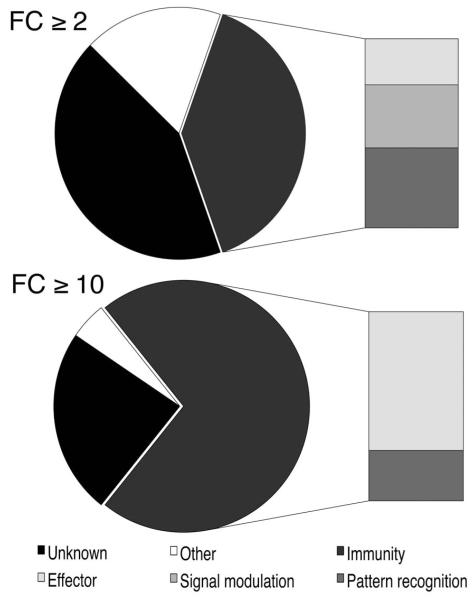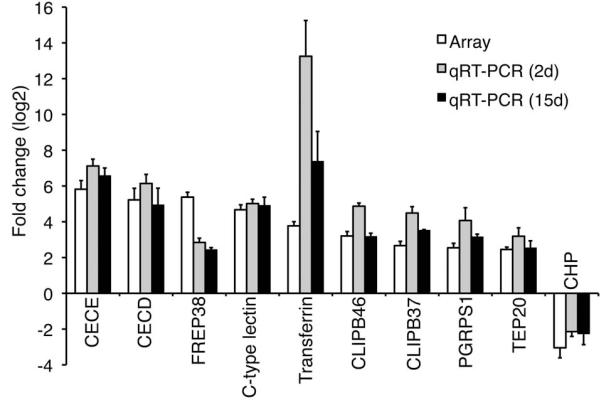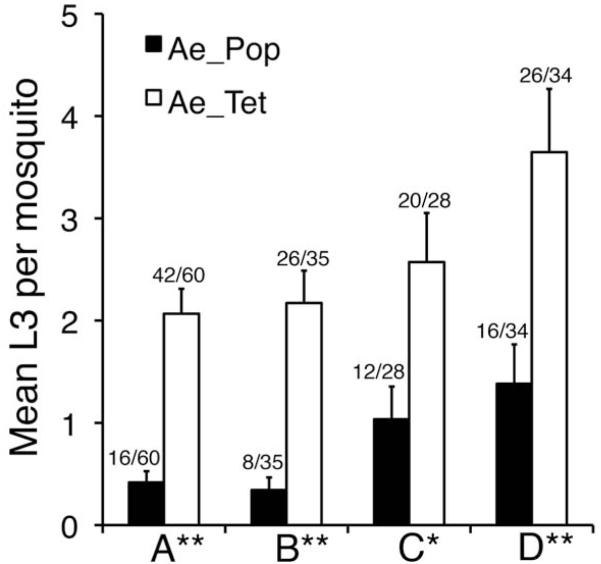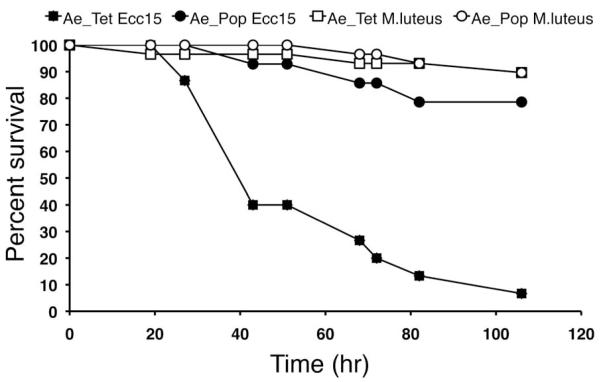Abstract
Wolbachia strain wMelPop reduces longevity of its Drosophila melanogaster host and halves lifespan when introduced into the mosquito Aedes aegypti. We show that wMelPop induces upregulation of the mosquito innate immune system and that its presence inhibits the development of filarial nematodes in the mosquito. These data suggest that wMelPop could be used in the global effort to eliminate lymphatic filariasis, and possibly the control of other mosquito-borne parasites where immune preactivation inhibits their development. The cost of constitutive immune upregulation may contribute to the life-shortening phenotype.
Wolbachia pipientis is a maternally inherited intracellular bacterium of invertebrates, capable of spreading itself through populations by reproductive manipulation such as cytoplasmic incompatibility (CI). The strain wMelPop or ‘popcorn’, unusually, reduces longevity of its Drosophila melanogaster host (1) and has been shown to also halve lifespan when the mosquito Aedes aegypti was stably transinfected (2). The wMelPop life-shortening phenotype offers the prospect of a novel disease control system by potentially skewing the population structure toward younger individuals. Vectorial capacity is particularly sensitive to mosquito age because mosquito-borne pathogens require an extrinsic incubation period between ingestion and transmission that is long compared to mean lifespan in the field, such that only older mosquitoes within a population are potentially infective. wMelPop was also found to be inherited at high rates and to induce strong cytoplasmic incompatibility (CI) in Ae. aegypti, providing a reproductive advantage to infected females. The wMelPop strain should be capable of spread through populations despite the reduction in mean lifespan, because the reproduction of older individuals makes a relatively small contribution to the next generation (2-6).
We compared host gene expression using whole genome microarrays in genetically identical Ae. aegypti lines infected and uninfected with wMelPop (7) to examine the mechanism underlying the life-shortening phenotype. Of 199 gene transcripts upregulated by more than a twofold threshold, 78 had putative immune-related functions (Fig. 1, table S2). These included genes that encode seventeen CLIP domain serine proteases, nine FREPs (fibrinogen-related proteins), six cecropins, four TEPs (Thio-ester containing proteins), three defensins, three PPOs (prophenoloxidases), two lysozymes, two PGRPs (peptidoglycan recognition proteins), two GNBPs (Gram negative binding proteins), and the NF-κB transcription factor Rel2. At higher levels of fold upregulation, effector genes, particularly cecropins and other antimicrobial peptides, dominate the list (Fig. 1, table S2). Five immune-related genes (primarily of regulatory predicted function) were downregulated below the twofold threshold (table S2).
Figure 1. Induction of immune gene transcription in wMelPop-infected female Ae. aegypti.
A summary of data from four replicate Ae. aegypti microarrays is shown as gene transcripts significantly upregulated in wMelPop-infected versus uninfected female mosquitoes. Of 199 upregulated gene transcripts with fold change (FC) ≥ 2 (p ≤ 0.05), a considerable proportion had a putative immune function (Immunity) compared with genes of other known function (Other) and unknown function (Unknown). Gene transcripts with immune-related function were categorized into effectors, signal modulation and pattern recognition. Gene transcripts encoding immune effectors dominated the list of highly upregulated genes (FC ≥ 10).
Quantitative RT-PCR (qRT-PCR) experiments, with mosquitoes at two and fifteen days post eclosion using a subset of immune-related genes, provided broad support for the array data (Fig. 2). Upregulation occurred at similar levels at both age points. This scale of constitutive or chronic immune upregulation (as opposed to the short–lived acute immune gene expression commonly observed following septic challenge) is unexpected. In Drosophila simulans and Aedes albopictus, naturally occurring Wolbachia was found to neither constitutively induce nor suppress the transcription of various inducible anti-bacterial genes (8). Constitutive upregulation of immune genes is known to have a high cost, and trade-offs between longevity and pathogen resistance associated with immune upregulation have been described in Drosophila melanogaster (9). Therefore constitutive upregulation of immune genes associated with wMelPop infection also provides a possible mechanism for, or contributory factor to, the life-shortening phenotype.
Figure 2. Microarray and qRT-PCR analyses of differentially regulated genes.
The differential regulation of transcript levels in wMelPop-infected Aedes aegypti versus a genetically identical uninfected Aedes aegypti line was examined for a selection of nine upregulated genes corresponding to two cecropins (CECE, AAEL000611; CECD, AAEL000598), a fibrinogen/fibronectin related protein (FREP38, AAEL0015428), a C-type galactose specific lectin (AAEL005641), a transferrin (AAEL0015458), two CLIP domain serine proteases (CLIPB46 AAEL005431, CLIPB37 AAEL005093), a Peptidoglycan recognition protein (PGRPS1, AAEL009474), a Thio-ester containing protein (TEP20, AAEL001794) and a conserved hypothetical protein that was downregulated (CHP, AAEL003467). The values shown are the mean (± SEM) of three different qRT-PCR experiments using independent samples, at two and fifteen days post eclosion.
The development of various pathogens is known to be inhibited by immune pre-activation in mosquitoes, which suggests that the constitutive immune regulation observed could influence the transmission of these pathogens to humans. For example, when Ae. aegypti was injected with bacteria 24 hour before challenge with Brugia filarial nematodes, causative agents of human lymphatic filariasis, significantly reduced prevalence and mean intensity of infection were observed (10). Synthetic cecropin peptides also have known filarial-killing activity (11); data from the microarray experiment showed that six cecropin genes were all upregulated by more than twenty five-fold in the presence of wMelPop (table S2).
We investigated the effect of wMelPop on filarial transmission. A filarial susceptibility locus from the susceptible Refm strain of Ae. aegypti was backcrossed into the wMelPop infected and control uninfected backgrounds using a visible marker linked to the susceptibility locus (7). Filarial challenge was then performed using a blood meal infected with Brugia pahangi microfilariae (a rodent filarial nematode previously shown to be a good model for studies of the genetics of susceptibility to infection by human filariae) (12). In comparison with the uninfected control line, significant reductions in the mean numbers of third larval stage (L3) infective worms, and in the prevalence of infected mosquitoes, were observed at three microfilarial densities when the wMelPop infection was present (Fig. 3). The inhibition effect was strongest at the lowest microfilarial density used, eleven microfilariae per μL blood, with 79.8% (A) or 84.2% (B) reductions in mean L3 stage larvae in the wMelPop infected line compared with the wMelPop-uninfected control. All microfilarial densities used are high compared with blood densities that would occur naturally.
Figure 3. wMelPop-infected mosquitoes show a reduction in filarial infection prevalence and intensity.
The mean numbers (± SEM) of infective third (L3) stage Brugia pahangi larvae are shown at 10-13 days post microfilarial challenge in Ae. aegypti wMelPop infected (Ae_Pop) versus uninfected (Ae_Tet) lines, that are filaria-susceptible following backcrossing with the Refm strain. Four independent challenge experiments are shown, using microfilarial densities of 11 (experiments A and B), 13 (C) and 23 (D) microfilariae / μl blood. Values above bars show the prevalence of filarial infection as a proportion of mosquitoes that contained at least one L3 Brugia larva over the total number of mosquitoes dissected in each category. Differences were significant at *P<0.01 or **P<0.001 (Mann-Whitney U test).
Filarial nematodes are somewhat harmful to mosquitoes. To investigate whether the presence of wMelPop conferred protective effects on other insect pathogens, the two lines were challenged by thoracic pricking with a virulent strain of the Gram-negative bacterium Erwinia carotovora. Higher survivorship was observed when wMelPop was present compared with the wMelPop-free control (Fig. 4). A control challenge with the Gram-positive bacterium Micrococcus luteus confirmed that the high mortality seen when the wMelPop-uninfected line was challenged with Erwinia was not simply a result of septic injury.
Figure 4. Increased resistance to a pathogenic bacterium in wMelPop-infected mosquitoes.
The daily survival rates (%) of Aedes aegypti carrying wMelPop (Ae_Pop) was compared to the Wolbachia free line (Ae_Tet) after infection with Erwinia carotovora 15 (Ecc15), a pathogenic Gram-negative bacterium. The horizontal axis represents the incubation time after infection in hours. Control infections with the Gram-positive Micrococcus luteus demonstrate that the early death / protection effects are not due to septic wounding alone.
Any protective effects provided against harmful pathogens commonly encountered by mosquitoes will act to increase the population spreading capacity of the wMelPop strain. However, any benefits accrued from pathogen protection in nature are likely to only partially offset the fitness costs associated with immune gene expression. The immune activation phenotype may be a side effect of the unusually fast replication of wMelPop, and / or because the immune evasion strategies normally employed by Wolbachia are impaired in this novel host. wMelPop Wolbachia must itself be at least partly resistant to the immune effectors induced, since it is maternally transmitted at high levels in infected Ae. aegypti (2).
Wolbachia infections, including wMelPop were recently reported to provide a protective function against pathogenic viruses in Drosophila (14, 15). The upregulation of immune genes provides a possible explanation or contributory factor, since there is a degree of overlap between immune peptides induced by bacteria and viruses (16, 17). Cecropins have previously been shown to have antiviral effects, for example inhibiting HIV-1 (human immunodeficiency virus 1) replication (18), and an artificial cecropin / defensin hybrid peptide inhibited dengue virus replication (19). Knockdown studies will allow these hypotheses to be tested. Cecropins are also known to have a major inhibitory effect on Plasmodium development (20, 21). Furthermore, the orthologs of Rel2, the TEP gene AAEL001794, and LRIM1 (AAEL012086), all upregulated in the presence of wMelPop, have been shown by knockdown studies in Anopheles to regulate the intensity of Plasmodium infection (22-27), as has mosquito midgut microbiota via immune stimulation (28). wMelPop transinfected Anopheles species should be tested for their ability to inhibit transmission of Plasmodium, to evaluate a novel malaria control strategy.
Around 120 million people across the tropics are infected with the filarial nematode species that cause lymphatic filariasis, a leading global cause of disability. Ae. aegypti is not a natural vector of the disease; however other Aedes species are primary regional vectors, such as Ae. polynesiensis in the South Pacific region. The need for novel control methods for Ae. polynesiensis has been previously highlighted (13). Sustained efforts at elimination in the region based on mass drug administration alone have failed, thought to be because Ae. polynesiensis is such an efficient vector of Wuchereria bancrofti, the main causative agent of human lymphatic filariasis, at low microfilarial densities. Another attractive target is Culex quinquefasciatus, the major urban vector of W. bancrofti across the tropics. These lines. Once stable wMelPop infections are created they would need to be challenged directly with W. bancrofti, since it remains possible that the effects observed are species specific, but the prospect of a self-spreading transmission reduction system is attractive particularly given that it is likely to be particularly effective when microfilarial densities in the human population are low.
The data reported here suggest wMelPop may represent a valuable new tool in the global effort to eradicate lymphatic filariasis, and possibly for the control of other mosquito-borne parasites. The combination of direct inhibitory / killing effects on filariae in the mosquito, together with lifespan shortening, could have a powerful overall impact in reducing disease transmission. The ability of wMelPop, in common with many other Wolbachia strains, to drive itself through populations using CI makes this a very attractive strategy.
Summary.
An inherited bacterium in a mosquito primes the host immune system and impairs the transmission of parasitic worms.
Supplementary Material
Acknowledgments
This study was supported by the Wellcome Trust, EC FP7 award 223241, EMBO, and University of Oxford John Fell Fund. We are very grateful to S. O’Neill for providing us with the wMelPop-infected and cured Ae. aegypti lines PGYP1 / PGYP1.tet; to E. Devaney, University of Glasgow for providing Brugia pahangi and Refm Ae. aegypti; to M. Povelones, Imperial College for assistance identifying Ae. aegypti LRIM genes; and to A. Brown for comments on the manuscript. Microarray data have been submitted to the NCBI GEO database, accession GSE17469.
References and Notes
- 1.Min KT, Benzer S. Proc. Natl. Acad. Sci. U.S.A. 1997;94:10792. doi: 10.1073/pnas.94.20.10792. [DOI] [PMC free article] [PubMed] [Google Scholar]
- 2.McMeniman CJ, et al. Science. 2009;323:141. doi: 10.1126/science.1165326. [DOI] [PubMed] [Google Scholar]
- 3.Sinkins SP, O’Neill SL. In: Insect Transgenesis: Methods And Applications. Handler AM, James AA, editors. CRC Press; Boca Raton: 2000. pp. 271–287. [Google Scholar]
- 4.Cook PE, McMeniman CJ, O’Neill SL. Adv. Exp. Med. Biol. 2008;627:126. doi: 10.1007/978-0-387-78225-6_11. [DOI] [PubMed] [Google Scholar]
- 5.Brownstein JS, Hett E, O’Neill SL. J. Invert. Pathol. 2003;84:24. doi: 10.1016/s0022-2011(03)00082-x. [DOI] [PubMed] [Google Scholar]
- 6.Rasgon JL, Styer LM, Scott TW. J. Med. Entomol. 2003;40:125. doi: 10.1603/0022-2585-40.2.125. [DOI] [PubMed] [Google Scholar]
- 7.Materials and methods are available as supporting material on Science Online.
- 8.Bourtzis K, Pettigrew MM, O’Neill SL. Insect Mol. Biol. 2000;9:635. doi: 10.1046/j.1365-2583.2000.00224.x. [DOI] [PubMed] [Google Scholar]
- 9.Libert S, Chao Y, Chu X, Fletcher SD. Aging Cell. 2006;5:533. doi: 10.1111/j.1474-9726.2006.00251.x. [DOI] [PubMed] [Google Scholar]
- 10.Lowenberger CA, et al. Exp. Parasitol. 1996;83:191. doi: 10.1006/expr.1996.0066. [DOI] [PubMed] [Google Scholar]
- 11.Chalk R, Townson H, Ham PJ. Exp. Parasitol. 1995;80:401. doi: 10.1006/expr.1995.1052. [DOI] [PubMed] [Google Scholar]
- 12.Meek SR, Macdonald WW. Ann. Trop. Med. Parasitol. 1982;76:347. doi: 10.1080/00034983.1982.11687551. [DOI] [PubMed] [Google Scholar]
- 13.Burkot TR, Taleo G, Toeaso G,V, Ichimori K. Ann. Trop. Med. Parasitol. 2002;96:S61. doi: 10.1179/000349802125002419. [DOI] [PubMed] [Google Scholar]
- 14.Hedges LM, Brownlie JC, O’Neill SL, Johnson KN. Science. 2008;322:702. doi: 10.1126/science.1162418. [DOI] [PubMed] [Google Scholar]
- 15.Teixeira L, Ferreira A, Ashburner M. PLoS Biol. 2008;6:e2. doi: 10.1371/journal.pbio.1000002. [DOI] [PMC free article] [PubMed] [Google Scholar]
- 16.Xi Z, Ramirez JL, Dimopoulos G. PLoS Pathog. 2008:e1000098. doi: 10.1371/journal.ppat.1000098. [DOI] [PMC free article] [PubMed] [Google Scholar]
- 17.Zambon RA, Nandakumar M, Vakharia VN, Wu LP. Proc. Natl. Acad. Sci. U.S.A. 2005;102:725731. doi: 10.1073/pnas.0409181102. [DOI] [PMC free article] [PubMed] [Google Scholar]
- 18.Wachinger M, et al. J. Gen. Virol. 1998;79:731. doi: 10.1099/0022-1317-79-4-731. [DOI] [PubMed] [Google Scholar]
- 19.Carballar-Lejarazú R, et al. Cell. Mol. Life. Sci. 2008;65:3081. doi: 10.1007/s00018-008-8250-8. [DOI] [PMC free article] [PubMed] [Google Scholar]
- 20.Gwadz RW, et al. Infect. Immun. 1989;57:2628. doi: 10.1128/iai.57.9.2628-2633.1989. [DOI] [PMC free article] [PubMed] [Google Scholar]
- 21.Kim W, et al. J. Med. Entomol. 2004;41:447. doi: 10.1603/0022-2585-41.3.447. [DOI] [PubMed] [Google Scholar]
- 22.Meister S, et al. Proc. Natl. Acad. Sci. U.S.A. 2005;102:11420. doi: 10.1073/pnas.0504950102. [DOI] [PMC free article] [PubMed] [Google Scholar]
- 23.Frolet C, Thoma M, Blandin S, Hoffmann JA, Levashina EA. Immunity. 2006;25:677. doi: 10.1016/j.immuni.2006.08.019. [DOI] [PubMed] [Google Scholar]
- 24.Garver LS, Dong Y, Dimopoulos G. PLoS Pathog. 2009;5:e1000335. doi: 10.1371/journal.ppat.1000335. [DOI] [PMC free article] [PubMed] [Google Scholar]
- 25.Blandin S, et al. Cell. 2004;116:661. doi: 10.1016/s0092-8674(04)00173-4. [DOI] [PubMed] [Google Scholar]
- 26.Povelones M, Waterhouse RM, Kafatos FC, Christophides GK. Science. 2009;324:258–261. doi: 10.1126/science.1171400. [DOI] [PMC free article] [PubMed] [Google Scholar]
- 27.Fraiture M, et al. Cell Host Microbe. 2009;5:273–284. doi: 10.1016/j.chom.2009.01.005. [DOI] [PubMed] [Google Scholar]
- 28.Dong Y, Manfredini F, Dimopoulos G. PLoS Pathog. 2009;5:e1000423. doi: 10.1371/journal.ppat.1000423. [DOI] [PMC free article] [PubMed] [Google Scholar]
Associated Data
This section collects any data citations, data availability statements, or supplementary materials included in this article.






